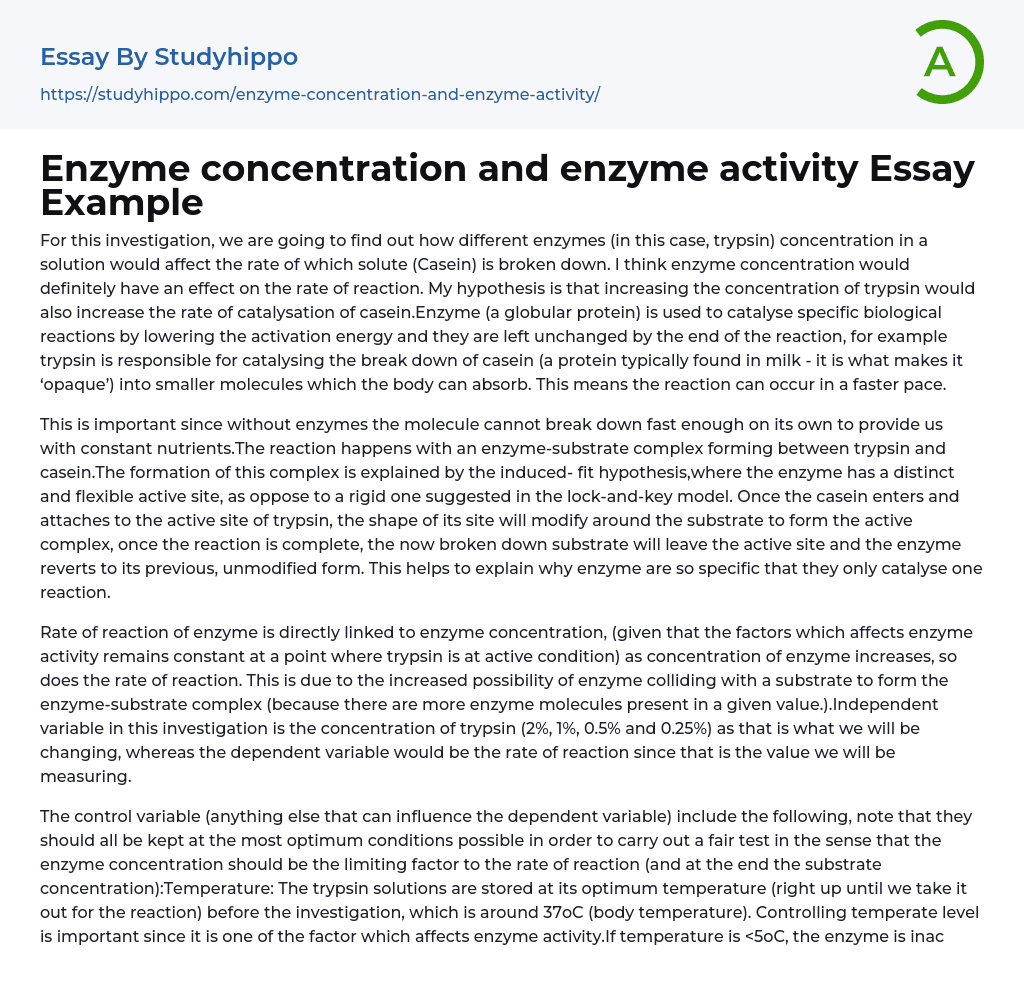For this investigation, we are going to find out how different enzymes (in this case, trypsin) concentration in a solution would affect the rate of which solute (Casein) is broken down. I think enzyme concentration would definitely have an effect on the rate of reaction. My hypothesis is that increasing the concentration of trypsin would also increase the rate of catalysation of casein.Enzyme (a globular protein) is used to catalyse specific biological reactions by lowering the activation energy and they are left unchanged by the end of the reaction, for example trypsin is responsible for catalysing the break down of casein (a protein typically found in milk - it is what makes it ‘opaque’) into smaller molecules which the body can absorb. This means the reaction can occur in a faster pace.
This is important since without enzym
...es the molecule cannot break down fast enough on its own to provide us with constant nutrients.The reaction happens with an enzyme-substrate complex forming between trypsin and casein.The formation of this complex is explained by the induced- fit hypothesis,where the enzyme has a distinct and flexible active site, as oppose to a rigid one suggested in the lock-and-key model. Once the casein enters and attaches to the active site of trypsin, the shape of its site will modify around the substrate to form the active complex, once the reaction is complete, the now broken down substrate will leave the active site and the enzyme reverts to its previous, unmodified form. This helps to explain why enzyme are so specific that they only catalyse one reaction.
Rate of reaction of enzyme is directly linked to enzyme concentration, (given that the
factors which affects enzyme activity remains constant at a point where trypsin is at active condition) as concentration of enzyme increases, so does the rate of reaction. This is due to the increased possibility of enzyme colliding with a substrate to form the enzyme-substrate complex (because there are more enzyme molecules present in a given value.).Independent variable in this investigation is the concentration of trypsin (2%, 1%, 0.5% and 0.25%) as that is what we will be changing, whereas the dependent variable would be the rate of reaction since that is the value we will be measuring.
The control variable (anything else that can influence the dependent variable) include the following, note that they should all be kept at the most optimum conditions possible in order to carry out a fair test in the sense that the enzyme concentration should be the limiting factor to the rate of reaction (and at the end the substrate concentration):Temperature: The trypsin solutions are stored at its optimum temperature (right up until we take it out for the reaction) before the investigation, which is around 37oC (body temperature). Controlling temperate level is important since it is one of the factor which affects enzyme activity.If temperature is <5oC, the enzyme is inactive, while if temperature is >40oC, it starts to become denatured and at 60oC, enzymes would be completely denatured. In both cases it means the enzyme can no longer carry out its function. Inactive state is when the enzyme still retained the shape of its active site but can no longer catalyse any reaction, whereas denatured means the enzyme has unravelled and completely lost its active site, and therefore cannot
return to its previous shape.
pH: Enzymes work best within their pH range, and trypsin’s optimum pH range is about 7.5-8.5, which is about neutral (if slightly alkaline) so it isn’t too hard to achieve. The effect pH has on trypsin is similar to that of temperature, as pH move further off the optimum pH range, the rate of reaction would decrease (a enzyme starts to denature), but if extreme pH are reached then the enzyme would become completely denatured and can no longer carry out its function.Substrate concentration: Substrate concentration affect rate of reaction in a similar way to enzyme concentration, however, since we’re instigating the effect of different concentration of enzyme, we must keep this variable constant - therefore we will be using 4% casein solution.
As substrate concentration increases, rate of reaction increase as there is more chances of the trypsin and casein colliding to form the enzyme-substrate complex.Volume of solutions added: Since the cuvette has a maximum capacity of 4 cm3, we have decided to use 2cm3 of trypsin solution with 2cm3 of casein solution, this must be kept constant as we’re only finding out the affect of enzyme concentration on rate of reaction, and amount of solutions added may affect that - i.e. if volume of enzyme solution increased, amount of active site available for catalysation would also increased. Having more than 1 independent variable would make the results unreliable since we would not know which factor was affecting the end result.
- Acid essays
- Calcium essays
- Carbohydrate essays
- Carbon essays
- Chemical Bond essays
- Chemical Reaction essays
- Chemical reactions essays
- Chromatography essays
- Concentration essays
- Copper essays
- Diffusion essays
- Ethanol essays
- Hydrogen essays
- Organic Chemistry essays
- Osmosis essays
- Periodic Table essays
- Ph essays
- Salt essays
- Sodium essays
- Titration essays
- Bacteria essays
- Biotechnology essays
- Breeding essays
- Cell essays
- Cell Membrane essays
- Cystic Fibrosis essays
- Enzyme essays
- Human essays
- Microbiology essays
- Natural Selection essays
- Photosynthesis essays
- Plant essays
- Protein essays
- Stem Cell essays
- Viruses essays
- Agriculture essays
- Albert einstein essays
- Animals essays
- Archaeology essays
- Bear essays
- Biology essays
- Birds essays
- Butterfly essays
- Cat essays
- Charles Darwin essays
- Chemistry essays
- Dinosaur essays
- Discovery essays
- Dolphin essays
- Elephant essays




